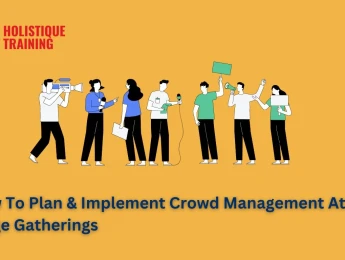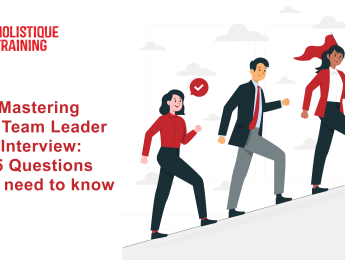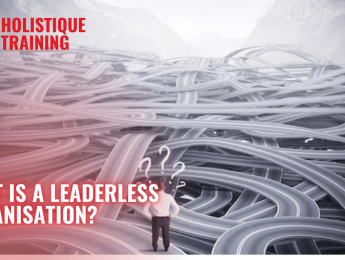- Table of Contents
- Introduction
- What is Crowd Management?
- Why is Crowd Management Important?
- 1. Safety of Attendees
- 2. Prevents Overcrowding and Congestion
- 3. Enhances the Overall Experience
- 4. Minimises the Risk of Conflict
- 5. Ensures Legal Compliance
- 6. Facilitates Efficient Emergency Response
- 7. Reduces the Risk of Property Damage
- 8. Helps With Crowd Psychology and Behavioral Management
- 9. Supports Sustainable Event Growth
- How to Create a Crowd Management Plan
- 1. Assess the Event and Venue
- 2. Determine Crowd Density and Flow Patterns
- 3. Develop a Risk Management Strategy
- 4. Staff Training and Deployment
- 5. Create Clear Communication Channels
- 6. Set Up Barriers and Physical Controls
- 7. Plan for Emergency Situations
- 8. Monitor and Adjust During the Event
- Tips for Crowd Control
- 1. Plan Early and Assess Potential Risks
- 2. Use Barriers and Physical Dividers
- 3. Ensure Clear Signage and Communication
- 4. Deploy Trained Crowd Control Personnel
- 5. Control Crowd Density
- 6. Leverage Technology for Real-Time Monitoring
- 7. Create Emergency Evacuation Plans
- 8. Promote a Calm and Controlled Atmosphere
- 9. Designate Clear Zones for Different Activities
- 10. Prepare for All Weather Conditions
- Differences Between Crowd Management and Events Risk Management
- What Does a Crowd Manager Do?
- Conclusion
Introduction
Navigating large groups of people can be a delicate balance between keeping the event enjoyable and maintaining safety. Whether it's a concert, a sporting event, a protest, or a festival, crowd management plays an integral role in ensuring everything goes off without a hitch. In this blog post, we'll explore the importance of crowd management, the skills required to be effective in this field, and how to create a crowd management plan. We’ll also highlight the role of a crowd manager, provide practical crowd control tips, and examine how crowd management differs from event risk management.
What is Crowd Management?
Crowd management refers to the systematic planning and supervision of large groups of people in confined or open spaces. It involves organising, directing, and controlling crowds to ensure safety and efficiency. This concept is not limited to large events; it is applicable in various settings, including shopping malls, airports, transportation hubs, and emergency evacuations. While some crowd management measures may seem invisible to the average participant, every element is designed to maintain the safety and well-being of individuals.
Crowd management is typically employed by event organisers, security professionals, facility managers, and law enforcement. Venues such as stadiums, arenas, and concert halls often have dedicated teams specialising in managing large crowds, ensuring an orderly flow of people, and preventing potential hazards. Crowded events, by their nature, pose risks such as stampedes, accidents, or conflicts. That's where crowd management becomes essential to prevent chaos, reduce risks, and keep everyone safe, and it’s becoming more crucial by the minute. In fact, the Crowd Management and Event Security Market, valued at USD 1.3 billion in 2023, is projected to exceed USD 9.7 billion by 2036, according to Research Nester.
Why is Crowd Management Important?
According to Medium, more than 2 billion people participate in large-scale events each year, highlighting the importance of crowd management as a key component of public safety. It is crucial for ensuring the safety, security, and success of any event or gathering involving large groups of people. While the primary goal is preventing accidents and chaos, effective crowd management goes far beyond maintaining order. It involves anticipating potential risks, planning for various scenarios, and executing strategies to minimise hazards while maximising the overall experience for attendees. Below, we dive deeper into why crowd management is important, focusing on its multifaceted benefits.
1. Safety of Attendees
The safety of participants is the number one priority of any event or public gathering. Without proper crowd management, there is an increased risk of accidents, stampedes, and even life-threatening situations. When large crowds form, the density and movement of people can create dangerous situations. Panic can spread quickly if no clear instructions or visible crowd control measures are in place. Proper crowd management ensures that everyone attending the event can navigate the space safely and that emergency services can access those in need if a problem arises.
Effective planning helps identify potential hazards, such as bottlenecks, overcrowded exits, or areas prone to trip hazards, and implements solutions to minimise risks. For instance, during music festivals or sporting events, where emotions run high and people move rapidly, safety measures like crowd monitoring and controlled entry points can prevent dangerous surges.
2. Prevents Overcrowding and Congestion
Overcrowding is one of the most common risks at large gatherings, and if left unchecked, it can lead to chaos and, in severe cases, trampling incidents. Crowd management strategies help prevent congestion and ensure that everyone has enough space to move safely by controlling the flow of people and limiting the number of attendees in certain areas. Controlled entry points, directional signage, and well-placed barriers can also reduce overcrowding risk, particularly in high-traffic zones such as entrances, exits, and popular areas.
When crowds are managed effectively, organisers can create a comfortable, spacious environment where individuals don’t feel trapped or stressed. This, in turn, reduces the likelihood of pushing, shoving, or panic behaviours that often arise in congested spaces.
3. Enhances the Overall Experience
Crowd management doesn’t just improve safety; it also enhances the overall experience for event attendees. When crowds are well-managed, people are free to focus on the event itself—whether it’s a concert, sporting event, or festival—without being distracted by long lines, blocked paths, or confusion over where to go. A smooth, organised event where attendees can easily navigate the venue without delays creates a more enjoyable atmosphere, leading to positive feedback and repeat attendance.
For organisers, this translates into a more successful event. Satisfied attendees are more likely to spread positive word-of-mouth, enhancing the venue or event's reputation for future gatherings.
4. Minimises the Risk of Conflict
Large crowds often bring together people with different personalities, behaviours, and emotions. This melting pot of attitudes can sometimes result in conflicts or aggressive behaviour, especially in situations where people feel stressed or confined. Crowd management can play a vital role in minimising the risk of altercations by reducing congestion and ensuring that attendees have clear pathways and sufficient space.
Additionally, visible security personnel and crowd control measures can deter individuals from engaging in disruptive behaviour. Crowd managers can intervene early to diffuse tensions before they escalate, ensuring a peaceful and positive environment for everyone present.
5. Ensures Legal Compliance
Organisers have a legal responsibility to ensure that events meet safety standards, and proper crowd management is often a key component of this. Failing to manage a crowd effectively can result in injuries, lawsuits, and reputational damage to both the event organisers and the venue. Regulatory agencies, such as fire departments and health and safety authorities, often require crowd control plans before issuing permits for large gatherings.
Crowd management strategies ensure compliance with local regulations, helping organisers avoid fines and legal consequences. Beyond legal compliance, organisers have a moral duty to provide a safe environment for attendees, and crowd management is a proactive way to meet this responsibility.
6. Facilitates Efficient Emergency Response
Emergencies can happen at any event, whether it's a medical situation, fire, or security threat. Managing the crowd can differentiate between life and death in these critical moments. A comprehensive crowd management plan ensures that emergency services can easily access the area, navigate the crowd, and assist those in need. It also ensures attendees can evacuate quickly and safely without causing panic or bottlenecks at exits.
Crowd management plans typically include contingency measures such as designated emergency routes, crowd dispersal tactics, and real-time monitoring systems. These protocols allow for swift action during emergencies and help reduce the overall risk to participants.
7. Reduces the Risk of Property Damage
Large groups of people can unintentionally damage the venue or surrounding infrastructure without proper crowd control. Overcrowding can strain barriers, fences, seating areas, and other structures, leading to wear and tear or outright damage. This is particularly a concern in venues that host frequent large-scale events.
Crowd management helps protect property by controlling people's movement and access to sensitive areas. It also ensures that the venue can continue hosting events without significant repair costs, reducing liability for event organisers and preventing additional financial loss.
8. Helps With Crowd Psychology and Behavioral Management
Crowds are highly influenced by psychological factors, including group behaviour and emotional contagion, where one person’s behaviour can rapidly spread to others. Panic can occur without clear directions or visible leadership, and even small disturbances can escalate into dangerous situations. This is where crowd management becomes critical, as it applies an understanding of human behaviour in crowds to create an environment of calm and order.
For instance, directing a crowd with subtle signals, such as colour-coded signs or staff in clearly marked uniforms, can instil a sense of control and organisation. People feel safer and more cooperative when they perceive someone in charge. Proper crowd management considers crowd psychology to prevent problems before they start, creating a more positive and predictable outcome.
9. Supports Sustainable Event Growth
Crowd management is key to sustainable growth for event organisers hosting recurring or expanding events. A well-managed event ensures attendees' safety and satisfaction and fosters long-term relationships with stakeholders, sponsors, and local authorities. When an event is executed successfully, it lays the foundation for future expansions and larger audiences, helping organisers scale their events while maintaining control over safety and logistics.
Effective crowd management builds trust with the public, vendors, and municipal services, all of whom are essential partners in ensuring that events can continue to grow without becoming unwieldy or dangerous.
How to Create a Crowd Management Plan
Creating a robust crowd management plan is essential for any event or gathering where large groups of people are expected. A well-designed plan ensures not only the safety of attendees but also the smooth execution of the event. It involves a detailed approach to understanding the event’s scale, environment, potential risks, and how to control and guide the crowd effectively. Here's a step-by-step guide on how to create an effective crowd management plan:
1. Assess the Event and Venue
The first step in creating a crowd management plan is conducting a comprehensive assessment of the event and the venue. This involves understanding the type of event, the expected number of attendees, and the venue layout. Different types of events, whether it’s a concert, sports event, festival, or rally, each present unique challenges when it comes to managing crowds.
Key aspects to assess include:
- Venue size and capacity: Know the maximum number of people the venue can safely accommodate, considering areas for circulation, seating, and standing.
- Ingress and egress points: Identify all entrances and exits, including emergency exits, to ensure that crowd movement can be controlled.
- High-risk areas: Evaluate any areas where bottlenecks might form, such as narrow corridors, stairways, or areas that could become overcrowded.
By assessing the venue’s layout, organisers can plan the flow of people and identify any potential safety hazards before the event starts.
2. Determine Crowd Density and Flow Patterns
One of the most critical aspects of crowd management is predicting crowd density and how people will move throughout the venue. This involves considering the peak times for entry and exit, as well as periods when attendees may congregate in certain areas, such as food stalls, restrooms, or main performance stages.
To create an effective plan:
- Establish crowd flow routes: Use barriers, signage, and staff to guide people along predetermined paths, helping to prevent overcrowding and ensure smooth movement.
- Calculate crowd density limits: For safety reasons, calculate how many people can occupy specific areas at once and monitor these limits during the event.
- Design entry and exit strategies: Ensure multiple points exist for entering and leaving the venue and, if possible, create staggered entry/exit times to avoid a sudden influx or rush of people.
3. Develop a Risk Management Strategy
Risk management is an integral part of crowd control. The plan should include a risk assessment to identify possible threats and create contingencies for managing them. Risks could include fire hazards, medical emergencies, weather-related disruptions, or security threats.
Steps to develop a risk management strategy include:
- Identify potential risks: Consider worst-case scenarios such as natural disasters, crowd surges, or violence, and anticipate how the crowd might react.
- Prepare contingency plans: For each identified risk, create a step-by-step plan for addressing it. This should include crowd dispersal methods, emergency evacuation routes, and coordination with local authorities or emergency services.
- Set up first aid and medical response areas: Have designated areas where medical personnel can respond to emergencies quickly. Ensure that medical staff are familiar with the venue and crowd dynamics.
4. Staff Training and Deployment
An essential component of any crowd management plan is having well-trained staff in place to manage different aspects of the event. From security personnel to crowd managers, every team member should understand their role and be equipped to handle various crowd scenarios.
Key considerations include:
- Train staff on crowd behaviour: Staff members should be able to identify signs of crowd distress, potential panic, or situations where crowd surges are likely to happen. This training should include both preventative measures and emergency response.
- Strategic positioning of staff: Place staff members at key points, such as entryways, high-traffic areas, and exits. They should be visible and approachable, ready to assist attendees and maintain order.
- Communication between staff: Equip staff with radios or communication devices to ensure they can stay connected and relay information quickly, especially in case of emergencies.
5. Create Clear Communication Channels
Effective communication is crucial for managing the crowd and ensuring everyone knows what to do in an emergency. This applies not only to staff members but also to the attendees.
Key elements of communication include:
- Public address systems: Use loudspeakers or megaphones to convey instructions, such as entry or exit directions, schedule updates, or emergency announcements.
- Clear signage: Place visible, easy-to-understand signage throughout the venue, directing people to exits, restrooms, help points, or first aid stations. Colour-coded or directional arrows can also help guide the crowd.
- Digital communication: For large-scale events, consider using apps, websites, or SMS alerts to provide attendees with real-time information, including entry points, event schedules, and safety updates.
6. Set Up Barriers and Physical Controls
Physical barriers play an important role in crowd management by guiding the flow of people and preventing overcrowded areas. Whether they are temporary fences, bollards, or ropes, barriers help keep crowds organised.
Best practices for using barriers:
- Guide movement: Use barriers to funnel people into designated lanes or routes, preventing them from assembling in unauthorised areas.
- Protect high-risk areas: Place barriers around stages, security checkpoints, and emergency exits to keep these spaces clear and accessible.
- Prevent surge points: Use stronger, more durable barriers to prevent surges in areas where crowds might push forward, such as the front of a stage or near a parade route.
7. Plan for Emergency Situations
No crowd management plan is complete without provisions for emergencies. Events can be unpredictable, and having a comprehensive emergency response plan can help organisers deal with unexpected situations efficiently.
Steps to prepare for emergencies include:
- Evacuation plans: Develop clear evacuation procedures, with well-marked exits and trained staff ready to guide attendees out of the venue calmly and quickly.
- Coordination with local emergency services: Work with fire, police, and medical services to ensure they are familiar with the venue layout and have access points in an emergency.
- On-site first aid: Ensure trained medical staff are present and equipped to handle injuries or emergencies. Set up first aid stations in inaccessible locations.
- Emergency drills: Before the event, run drills with staff to test their readiness and identify any weaknesses in the emergency plan.
8. Monitor and Adjust During the Event
Finally, crowd management is a complex task. It requires continuous monitoring and adjustments based on real-time conditions. Use cameras, drones, or on-the-ground personnel to observe the crowd, detect potential issues, and adapt plans as needed.
Real-time monitoring tips:
- Use surveillance tools: Install cameras or drones to monitor large crowds from multiple angles. This helps identify areas where congestion might occur and allows for quick intervention.
- Deploy response teams: Have teams on standby who can respond quickly to potential issues, such as overcrowding or safety hazards.
- Make adjustments: If conditions change unexpectedly, be flexible and prepared to alter routes, open additional exits, or modify crowd flow.
In short, a well-thought-out crowd management plan is critical for ensuring the safety and success of any event. By assessing the venue, predicting crowd behaviour, training staff, and planning for emergencies, event organisers can create an environment where attendees can enjoy themselves in a safe and controlled manner.
Metric | Description |
Crowd density | Monitors the number of people in designated areas. |
Flow Rate | Measures the speed at which crowds move through areas. |
Incident Reports | Tracks the frequency of security or safety incidents. |
Evacuation Time | Assesses the time taken for safe crowd evacuation.. |
Visitor Satisfaction | Gauges attendee feedback on their event experience. |
Table 1: Metrics to Measure a Crowd Management Plan
Tips for Crowd Control
Effective crowd control ensures attendees' safety, comfort, and enjoyment at large events or gatherings. Properly managing crowds involves anticipating potential issues, guiding the flow of people, and reacting swiftly to prevent problems from escalating. Below are several practical tips for successful crowd control:
1. Plan Early and Assess Potential Risks
Good crowd control starts with early planning. To identify potential challenges, assess the type of event, expected audience size, and venue layout. Understanding crowd psychology and behaviour in various situations is also crucial for planning.
Key points to consider:
- Estimate crowd density during peak times (such as event start, break periods, and end).
- Identify potential choke points and areas prone to congestion.
- Consider worst-case scenarios like crowd surges or sudden exits, and prepare responses.
2. Use Barriers and Physical Dividers
Barriers are one of the simplest yet most effective tools for crowd control. They create clear boundaries that guide people and prevent them from entering restricted or high-risk areas.
Best practices for using barriers:
- Set up clear entry and exit lanes: Use barriers to funnel crowds through designated pathways, reducing the likelihood of bottlenecks and confusion.
- Prevent crowd surges: Place sturdy barriers in front of stages or parade routes to prevent people from pushing forward.
- Secure key areas: Use barriers to block access to restricted zones such as backstage areas, VIP sections, or emergency exits.
3. Ensure Clear Signage and Communication
Clear and visible communication is vital for guiding large crowds, especially in unfamiliar or complex venues. Attendees need to know where to go, how to exit, and where to find amenities like restrooms or food stands.
Tips for effective communication:
- Use large, well-lit signs: To direct people efficiently, position signs at strategic points, such as intersections or near exits.
- Implement digital communication: For larger events, use apps or digital displays to provide real-time updates about crowd movement, schedule changes, or safety instructions.
- Train staff to communicate clearly: Ensure staff members are well-informed and equipped with radios or communication devices to provide real-time guidance or alerts to attendees and other staff members.
4. Deploy Trained Crowd Control Personnel
One of the most effective ways to manage crowds is to have a visible, well-trained staff presence. Staff members, including security personnel, can help guide attendees, prevent congestion, and respond to any issues that arise.
Staff deployment strategies:
- Position staff at key points: Place personnel at entrances, exits, restrooms, food areas, and other high-traffic zones. These staff members should monitor crowd flow and assist in managing any congestion.
- Train for emergencies: Staff should be trained to handle emergencies calmly, ensuring they can evacuate people or intervene during crowd surges.
- Use security for enforcement: Security teams should be well-trained in nonviolent crowd control techniques and should be placed in areas where tensions or disturbances may arise.
5. Control Crowd Density
Managing crowd density is crucial to avoiding dangerous situations such as crowd surges or stampedes. Keeping the crowd spread out, particularly in high-traffic areas, can prevent pressure from building.
Methods for managing crowd density:
- Stagger arrivals and exits: If possible, stagger the flow of people entering and exiting the event to prevent a sudden influx or rush.
- Set up waiting areas: For events with timed sessions or performances, designate holding areas where people can wait comfortably before being allowed into the main space. This reduces crowd pressure at entry points.
- Monitor capacity limits: Ensure that the venue’s capacity is not exceeded, particularly in enclosed areas like auditoriums or stadiums. Use counters or ticketing systems to monitor the number of people entering specific zones.
6. Leverage Technology for Real-Time Monitoring
Modern technology offers powerful tools for crowd control, allowing event organisers to monitor crowd density and flow in real time. This enables quicker responses to potential problems before they escalate.
Technological solutions include:
- Surveillance cameras and drones: Install cameras to monitor the entire venue and provide security teams with a bird’s-eye view of the crowd. This allows quick identification of areas where crowding is becoming problematic.
- Crowd management software: Some events use software that tracks crowd movement and alerts organisers to potential overcrowding. This helps prevent issues such as bottlenecks or congestion in real time.
- Digital check-in systems: Using electronic ticket scanning or RFID wristbands can help control the flow of attendees and track the number of people in different venue areas.
7. Create Emergency Evacuation Plans
Even the best crowd control measures can sometimes fail in an emergency. Having a clear, well-practised emergency evacuation plan is critical to maintaining crowd safety under pressure.
Best practices for evacuation planning:
- Identify multiple exit routes: Ensure there are enough exits for the size of the crowd, and mark them clearly with illuminated signs.
- Train staff in emergency procedures: Every staff member should know the emergency plan and be prepared to guide attendees out of the venue safely.
- Use public address systems: In the event of an emergency, use loudspeakers or a public address system to provide clear, calm instructions to the crowd.
- Conduct evacuation drills: Rehearse emergency scenarios with staff ahead of the event to test the efficiency of your evacuation procedures.
8. Promote a Calm and Controlled Atmosphere
The atmosphere of an event can often influence crowd behaviour. Organisations that foster a calm and orderly environment can prevent unnecessary tension or panic among attendees.
Ways to promote a calm atmosphere:
- Play soothing music: In waiting areas or during breaks, use calming background music to help keep the crowd relaxed.
- Provide ample facilities: Ensure there are enough restrooms, seating areas, and food stands to prevent attendees from feeling frustrated or uncomfortable.
- Encourage patience: Use signage, announcements, or staff interactions to encourage people to remain patient and follow the event’s rules.
9. Designate Clear Zones for Different Activities
Allocating specific zones for different activities, such as seating, standing, eating, and moving, is important to avoid overcrowding in any particular area. This ensures that no single area becomes overwhelmed.
Zoning strategies:
- Create separate entry and exit paths: Designate separate paths for entering and leaving the venue to avoid mixing incoming and outgoing crowds.
- Mark different activity areas: Clearly mark areas for eating, socialising, and watching performances. This helps keep people moving through the venue instead of clustering in a single space.
- Use fencing or ropes for crowd flow: For outdoor or festival-type events, use fencing or ropes to guide attendees from one area to another without creating congestion points.
10. Prepare for All Weather Conditions
Weather can significantly impact crowd behaviour, especially at outdoor events. Rain, excessive heat, or cold can all lead to unexpected crowd control challenges.
Weather-related crowd control tips:
- Provide shelter or shade: Set up tents or other structures where attendees can take cover in case of rain or intense heat.
- Plan for slippery surfaces: In case of wet weather, place warning signs on potentially slippery surfaces and ensure that walkways are kept clear of hazards.
- Hand out water and cooling supplies: If the event occurs during hot weather, provide attendees with water or fans to prevent heat-related crowd issues like dehydration or fainting.
By following these crowd control tips, organisers can ensure a safe, well-organised, and enjoyable experience for all attendees while reducing the likelihood of overcrowding, accidents, or disturbances.
Differences Between Crowd Management and Events Risk Management
While crowd management and event risk management often go hand in hand, they are distinct concepts. Crowd management focuses on controlling and directing the flow of people to ensure safety and order during events. It includes the physical organisation of the space, managing entry and exit points, and monitoring the crowd’s behaviour.
Crowd Management | Event Risk Management |
Focuses on controlling crowd flow and behaviour. | Identifies and mitigates potential event risks. |
Ensures safety during events with large crowds. | Assesses threats to the event's overall success. |
Involves planning for crowd density and access. | Develops contingency plans for emergencies. |
Emphasises proactive measures for crowd safety. | Focuses on risk analysis and management strategies. |
Table 2: Difference Between Crowd Management and Event Risk Management
On the other hand, events risk management is a broader concept that addresses all potential risks associated with an event. This includes crowd control and other risks such as equipment failure, adverse weather conditions, security threats, or fire hazards. Risk management involves identifying, assessing, and mitigating these risks through insurance policies, contingency plans, and on-site emergency services. While crowd management is one component of risk management, the latter encompasses a more comprehensive approach to ensuring the safety and success of the event.
What Does a Crowd Manager Do?
A crowd manager is responsible for the safe movement and control of large groups of people. This role requires keen observational skills, quick decision-making abilities, and excellent communication. Crowd managers work closely with event planners, security teams, and emergency services to ensure everything runs smoothly. Their duties include:
- Monitoring crowd density: Crowd managers constantly observe crowd behaviour to detect any signs of congestion, agitation, or unsafe conditions.
- Directing crowd flow: They guide people through the venue, ensuring that attendees are moving safely through entry points, exits, and common areas.
- Coordinating with security: Crowd managers work hand-in-hand with security personnel to prevent conflicts, handle unruly behaviour, and maintain a safe environment.
- Responding to emergencies: In the event of an emergency, such as a fire or medical situation, crowd managers help guide people to safety, coordinate with emergency services, and manage evacuations.
- Post-event analysis: After the event, crowd managers review the effectiveness of crowd control measures, document any incidents, and suggest improvements for future events.
Conclusion
Crowd management is an essential element of hosting any event or gathering where large groups of people are expected. From ensuring safety to enhancing the overall experience, crowd management requires strategic planning, skilled personnel, and constant vigilance. Whether it’s through proactive measures like creating detailed management plans or reactive techniques such as crowd control, the success of any event hinges on how well the crowd is managed. By understanding the roles and responsibilities of a crowd manager and implementing effective strategies, organisers can ensure their events are both safe and enjoyable.
To master these skills and elevate your event planning expertise, our Advanced Events Management course covers everything you need to know about professional crowd management. You'll gain practical insights, expert-led training, and tools that help you develop comprehensive management plans. Enrol today and take the next step toward ensuring your events are well-managed and highly successful.

























